
Ozothamnus ferrugineus, commonly known as tree everlasting, is a member of the genus Ozothamnus, of the Asteraceae family – one of the largest families of flowering plants in Australia. Native to the Australian states of New South Wales, Victoria, South Australia, and Tasmania, it forms an erect shrub or small tree between 2 and 3 metres in height.

Olearia phlogopappa commonly known as the dusty daisy-bush or alpine daisy-bush is a species of flowering plant in the family Asteraceae that is commonly found in eastern New South Wales, Victoria and Tasmania. It is a small shrub with greyish-green foliage, daisy-like flowers in white, pink or mauve that can be seen from spring to late summer.

Pultenaea muelleri, commonly known as Mueller's bush-pea, is a species of flowering plant in the family Fabaceae and is endemic to Victoria, Australia. It is a dense shrub with hairy stems, elliptic to narrow egg-shaped leaves with the narrower end towards the base, and yellow and red flowers arranged singly or in pairs on the ends of short side shoots.

Podolobium alpestre, commonly known as alpine shaggy-pea, is a flowering plant in the family Fabaceae and is endemic to south-eastern Australia. It has oblong to egg-shaped leaves and yellow to orange pea-like flowers with red markings.

Ozothamnus secundiflorus, the cascade everlasting, is an aromatic shrub species, endemic to Australia. It grows to between 0.5 and 2 metres in height. Leaves are 6 to 10 mm long and 1.5 to 4 mm wide. These are dark green with grey hairs on the upper surface, and white tomentose below. The white flower heads appear in dense clusters along one side of the stem between December and February in the species' native range.

Hovea lanceolata is a flowering plant in the family Fabaceae. It is a small shrub with elliptic leaves and purple pea flowers. It grows in New South Wales and Queensland.
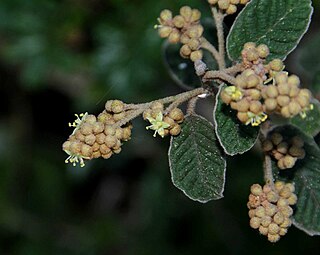
Pomaderris oraria, commonly known as Bassian dogwood, is a species of flowering plant in the family Rhamnaceae and is endemic to south-eastern Australia. It is a compact shrub with hairy branchlets, hairy, elliptic leaves and panicles of hairy, greenish to cream-coloured or crimson-tinged flowers.

Olearia floribunda, commonly known as heath daisy-bush, is a species of flowering plant in the family Asteraceae and is endemic to south-eastern Australia. It is an upright, spreading shrub with egg-shaped leaves and white and yellow or mauve, daisy-like inflorescences.
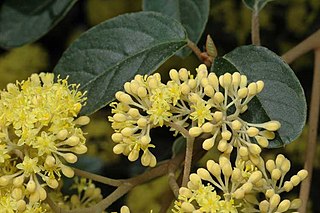
Pomaderris elliptica, commonly known as yellow dogwood or smooth pomaderris, is a species of flowering plant in the family Rhamnaceae and is endemic to south-eastern Australia. It is a shrub with densely hairy branchlets, egg-shaped or elliptic leaves, and pale yellow flowerss.
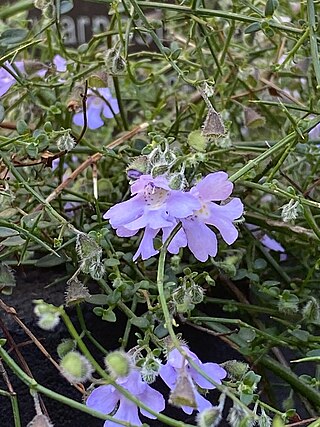
Prostanthera spinosa, commonly known as spiny mintbush, is a shrub that is endemic to south-eastern Australia. It has mauve to white flowers, spiny stems and aromatic foliage.

Cassinia longifolia, commonly known as shiny cassinia, is a species of flowering plant in the family Asteraceae and is endemic to eastern Australia. It is an erect, aromatic shrub with sticky, hairy foliage, linear or oblong to narrow lance-shaped leaves, and heads of creamy-white flowers arranged in a dense corymb.

Bossiaea decumbens is a spreading, prostrate shrub in the pea family (Fabaceae), and is endemic to Victoria. It has alternate, variable shaped leaves and yellow pea flowers with red splotches from spring to late summer.

Olearia minor, is a small flowering shrub in the family Asteraceae. It has alternate leaves and white to pale mauve daisy-like flowers from winter to December. It grows in Western Australia, South Australia, New South Wales, and Victoria.

Craspedia aurantia, is a flowering plant in the family Asteraceae and grows in New South Wales and Victoria. It has light green leaves and heads of yellow to reddish-brown flowers on a single flowering stem.
Ozothamnus tesselatus, commonly known as tesselate everlasting, is a flowering plant in the family Asteraceae. It is a small shrub with woolly branches and globular heads of whitish to straw-coloured flowers.
Pomaderris briagolensis is a species of flowering plant in the family Rhamnaceae and is endemic to Victoria, Australia. It is a shrub with hairy branchlets, egg-shaped or oblong leaves and panicles of white to rust-coloured flowers.

Spyridium burragorang, is a flowering shrub in the family Rhamnaceae. It has dense clusters of whitish flowers at the end of branches, alternate leaves and is endemic to New South Wales.
Pomaderris virgata, commonly known as upright pomaderris, is a species of flowering plant in the family Rhamnaceae and is endemic to south-eastern continental Australia. It is an erect, slender shrub with hairy branchlets, lance-shaped, narrowly elliptic or oblong leaves, and dense panicles of golden-yellow flowers.
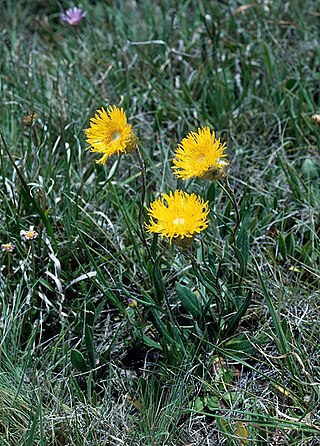
Podolepis decipiens, commonly known as deceiving copperwire-daisy, is a flowering plant in the family Asteraceae and grows in Victoria, Tasmania and New South Wales. It is an upright, perennial herb with yellow daisy-like flowers on a single stem rising from a sparse rosette.
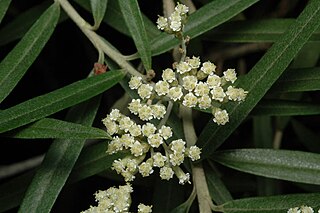
Ozothamnus stirlingii, commonly known as Ovens everlasting, is a flowering plant in the family Asteraceae and grows in New South Wales, Victoria and the Australian Capital Territory. It has globose-shaped white flower heads and sticky leaves.

















